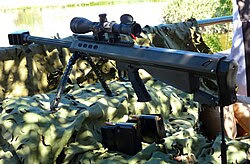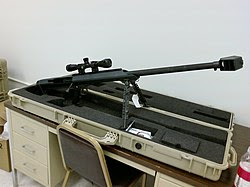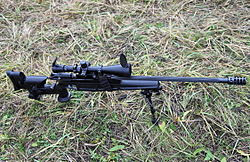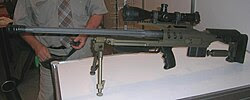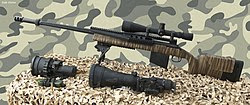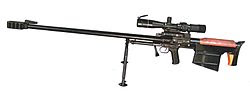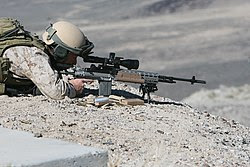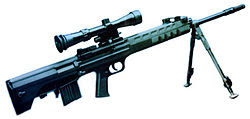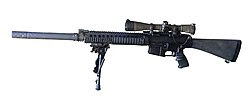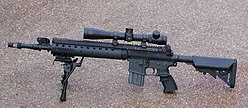Category: Cops
List of Sniper Rifles


 I am sure glad that I did not have to carry this one!
I am sure glad that I did not have to carry this one!




Syracuse Cops Force Doctors to Probe a Man’s Rectum for Drugs, Then Bill the Man For It
Similar cases have resulted in huge lawsuits against hospitals and police departments.

Mathayward | Dreamstime.comSyracuse
police obtained a search warrant from a judge to compel doctors to perform an invasive rectal probe of a man they suspected of hiding drugs, even after an x-ray showed nothing out of the ordinary.
And after the scope likewise turned up no drugs, the man was billed more than $4,000 for the procedure.
Syracuse.com reports that Syracuse police, a city judge, and St. Joseph’s Hospital Health Center “collaborated to sedate” Torrence Jackson after he was arrested following a traffic stop “and thread an 8-inch flexible tube into his rectum in a search for illegal drugs.”
The suspect, who police said had taunted them that he’d hidden drugs there, refused consent for the procedure.
At least two doctors resisted the police request. An X-ray already had indicated no drugs. They saw no medical need to perform an invasive procedure on someone against his will.
The notes from police and doctors suggest some tension, a standoff. At one point, eight police officers were at the hospital. A doctor remembers telling officers: “We would not be doing that.”
The hospital’s top lawyer got pulled in. He talked by with the judge who signed the search warrant, which was written by police and signed at the judge’s home. When they were done, the hospital lawyer overruled the doctors. The lawyer told his doctors that a search warrant required the doctors to use “any means” to retrieve the drugs, records show.
Jackson was then hooked up to an IV against his will and put under general anesthesia while doctors performed a sigmoidoscopy. No drugs were found.
According to the story, Jackson was arrested after a pretextual traffic stop where officers found a baggie of marijuana and detected cocaine residue on his car seat.
Jackson has a long rap sheet and was combative with police in jail, but the encounter crossed into dubious ethical and legal territory when police compelled doctors to perform a medical procedure they saw as unnecessary.
Previous cases like this have resulted in police and hospitals paying out huge amounts of money to settle lawsuits.
In 2016, the federal government and an El Paso hospital agreed to pay a New Mexico woman roughly $1.6 million dollars for the six hours of invasive cavity searches she was subjected to after a Customs and Border Patrol (CBP) drug-sniffing dog alerted to her.
In 2014, the city of Deming, New Mexico, paid David Eckert $1.6 million after he was subjected to two X-rays, two digital probes of his anus, three enemas, and a colonoscopy in an ultimately vain search for drugs.
In another 2014 settlement, CBP and the same El Paso hospital agreed to pay out $1.1 million to a woman who endured a similarly degrading series of cavity searches.
“Aside from the vaginal probe and CT scan, the woman also underwent a forced observed bowel movement, a rectal exam and an X-ray,” the Texas Tribune reported. “She was eventually released six hours later then billed $5,000 because she refused to sign a consent-to-search statement.”
The drug charges against Jackson resulting from the traffic stop were thrown out. Jackson has refused to pay for the unwanted medical procedure, and the hospital is now threatening to send him to collections.
See also: ReasonTV’s video on the 2012 case of Timothy Young, who was handcuffed by Hidalgo County deputies and driven to a nearby hospital, where he was x-rayed and digitally probed against his will. No drugs were found.
Photo Credit: Mathayward | Dreamstime.com

I’d removed the barrel from my 870 so that it would fit into the case a little easier. Rather than open its action, she grasped the receiver and slide in a few places, as if gauging the firmness of a big zucchini. Then she held the barrel up, squinting one eye as she peered through the muzzle with the other.
Satisfied with that, she then picked up my carry gun, which, unlike her Glock, has a manual safety that at first prevented her from cycling the slide. She began wrenching on it like a frustrated toddler.
You have to take the safety off first,” I said softly. “It’s right there.”
Tempted as I was to say something clever, the sure outcome of any smartassery would’ve been more time spent in the airport back room with my new friends, and I had no interest in that. I kept my mouth shut, and a few minutes later, I was on the way to my gate.
Flying with firearms makes people nervous, and I’m frequently asked about the difficulty of it. I fly 10 to 12 times a year, and almost always with a firearm. Most trips end without any delays or questions from security. But on occasion, situations like the one I just described—which happened to me after a turkey hunt last spring—do arise.
If you’re not prepared, you might have a long day and some probing in your future. You don’t want that. Plan ahead and be informed, and nothing in your travels with guns will be unmanageable.
Know the Rules
TSA rules for flying with firearms are explicit and easy to understand, and they apply to every domestic airline. Read them here.
Some airlines (and airports) implement rules of their own, but in general, if you understand and follow the TSA rules without exception, you will be O.K.
Your firearm and ammunition must be in your checked baggage. Gun parts—magazines, choke tubes, bolts, etc.—need to stay in your checked bags as well. You can throw a fit in the security line and argue over the harmlessness of a choke tube, but it won’t do you any good—and it could be the first step toward that probing I mentioned earlier.
You can’t just drop your .45 in your suitcase, either. To legally check your firearm, you need a hard-sided case that meets TSA specifications (most appropriate cases are labeled as such). I’ve flown all over the country with a $30 hard-sided plastic pistol case with a pair of padlocks on it. I have checked rifles and shotguns alike in a basic $40 Plano case as well, but if you’re protecting optics, it’s worth investing in a beefier case.
Pistol cases can be put inside other checked luggage; long guns need to be checked in individual bags. Be certain to remove any detachable magazines, and check twice to ensure that the gun is unloaded. A limited amount of ammunition can be checked in the case alongside the firearm or separately in your luggage, but it must also be packaged per TSA regulations. The easiest thing to do is to keep ammo in its factory packaging. Don’t forget any loose rounds in pockets or packs. You don’t have to use TSA locks to secure your gun case, but they do make life easier. Ensure that there are no potential access points into your case, particularly if you’re using a plastic case, which has corners that can be pried open. When in doubt, add another lock.
Once you’re positive that everything is secured properly, arrive at the ticket counter at least 30 minutes earlier than normal. You’re required to “declare” your firearm to the airline immediately upon checking in. It’s better to softly say, “I’m checking a rifle and ammunition,” than to loudly say, “I’ve got a gun!”
After that, you’ll be required to sign a declaration form that your firearm is unloaded. They may ask to see inside the case, they may call for a TSA inspection on the spot, or they may tape the form to your case and send you on your merry way. Be prepared for any of the above—but do not allow the firearm to leave your possession unless the case is locked and you have the keys. If your firearm is sent down the line, hang out for 10 to 15 minutes before heading through security yourself, because you could very well be called to unlock the case for an inspection.
Some people who dislike guns also work at airports—especially around major metropolitan areas. If you sense that someone is uncomfortable around your firearm, then they probably are. Even personnel tasked with their inspection, like TSA officers or airport police, may not know much of anything about guns. That’s why it’s worth hanging out a few extra minutes with the keys to your locks, just so you can be present if they need to look inside your case.
Once you’re called into the back room, you can give them a good rant about your Second Amendment rights, their ineptness, and the overall wretched state of their administration. But that won’t get you to your gate or back home any faster. Being cordial and helpful—but saying nothing more than what’s needed—-probably will.
TIP OF THE MONTH: Airports and Archery Gear
Interestingly, I’m stalled in security more consistently with bowhunting tackle than with firearms. In fact, I can recall one hunt where the security officer virtually ignored the locked pistol case in my bag but spent 15 minutes inspecting the innards of my bow case. Although you’re not required to declare archery tackle, the TSA may want to see it anyway—and you don’t want them tampering with your bow unsupervised. That advice about arriving early if you’re flying with guns applies to flying with bows, too. —W.B.

Well I thought it was funny until I either get a ticket or shot next time I get pulled over! Grumpy
What Should You Do If There’s an Active Shooter in the Office?

If you heard gunshots at work, would you know what to do?
Would you know the fastest escape route or the best place to hide? And if it came down to saving your own life and those of your co-workers, would you be prepared to fight back?
Media reports to the contrary, mass shootings actually are more likely to occur in places of business than schools. When the FBI studied active shooter cases from 2000 to 2013, it found that 45.6 percent of the incidents happened in areas related to commerce (like offices and malls).
This was followed by environments related to education (like schools and colleges) at 24.4 percent.
And the number of shooting incidents keeps rising: In 2000, there was one active shooter incident, resulting in seven casualties, according to the FBI; in 2017, there were 30, resulting in 729 casualties.
The FBI defines an active shooter as “an individual actively engaged in killing or attempting to kill people in a populated area.”
The truth is that none of us really knows how we’d respond in the unlikely event of an active shooter in the office. Which is exactly why education and preparation are so important, so you’ll know what to do in such a terrifying situation.
Rob Berryman is a safety consultant with the American Contractors Insurance Group who presents frequently at risk management conferences about active shooter training and response.
One of Berryman’s favorite sayings is, “People don’t rise to the occasion. They retreat to their level of training.”
While nothing replaces a thorough, in-person training by active shooter response specialists like the ALICE Training Institute, Berryman shared some life-saving tips for how to survive an active shooter attack in an office.
His tips are organized under the active shooter survival mantra: Run. Hide. Fight.
If You Can Escape, Run
The first and best option in any active shooter situation is to escape to safety. But to do this, you first need to know all of the exits and escape routes in the office.
This is why it’s so important to plan for precisely this kind of emergency. Every worker needs to ask themselves, “If I’m at my desk, on the elevator, in the break room or in the bathroom, what’s the quickest way out?”
If the shooter isn’t yet in your area of the office, stay low and move as quickly as you can toward the nearest exit. Don’t hesitate and always keep moving.
While fleeing, prevent anyone else from entering the building. Only when you’re free and clear of the immediate danger should you call 911.
If You Can’t Get Out Quickly, Hide
This is not an “old-school lockdown,” says Berryman. Hiding does not mean passively huddling in the corner of an office. Sadly, that only makes it easier for shooters once they discover the hiding place.
Law enforcement and training experts recommend a much more “active” form of hiding intended to keep the shooter out or escape if possible.
Again, knowing the best hiding places in the office requires planning ahead. The ideal locations are rooms with thick walls that can be locked from the inside.
Cubicle walls won’t stop a bullet, and glass-walled conference rooms can be shot open. Even doors with glass panels are too risky.
Many office walls are made of thin drywall, which also is too weak to stop a bullet. Interior rooms closest to an elevator shaft tend to have thicker, reinforced walls.
If none of the rooms in your office have locks, you need to know what it takes to keep that door closed. That means knowing which doors open inward and which open outward.
Doors that open inward can be barricaded with heavy pieces of furniture (filing cabinets, refrigerators, desks) or jammed closed with a pair of rubber doorstops.
For doors that open outward, Berryman recommends tying an electrical cord around the door handle and using two or more people to pull hard on the cord to keep the door closed.
If an outward opening door has a hydraulic arm at the top, you can tie a belt tightly around the v-shaped arm and door won’t open.
“Shooters are opportunistic,” says Berryman. “They’re holding a gun, so they only have one free hand to work with. If you can secure that door using any and all means, it’ll be harder to get inside one-handed.”
Remember that hiding is still your second-best option. If your hiding place is on the first or second floor, consider escaping through a window.
That’s what saved several students’ lives during the Virginia Tech shooting. A brave teacher corralled his students out the window before the shooter breached the door.
If you need to break the window to escape, smash it from a top corner using any heavy object, including a chair, fire extinguisher or “salesman of the year” trophy.
Clear out as much glass as possible before escaping, not forgetting hanging glass shards above you. If you’re on the second floor, hang by your hands from the window ledge to lessen the distance of the fall.
If All Else Fails, Fight Back
Fighting back does not mean actively seeking out the shooter and facing him one on one. Instead, it’s the last resort if the shooter breaks into your hiding place, but one that could save many lives, including your own.
While hiding, you and your co-workers need to be ready to react quickly if that door opens. That means staying low, but not sitting or laying down on the floor. Grab anything available that you can throw at the shooter or use as a weapon.
“I challenge people to go back to their desk and find five things that can defend themselves with,” says Berryman. “Staplers, scissors, coffee mugs, anything.”
The first defense if the shooter gets through the door is to throw stuff directly at his face. Berryman, a certified self-defense instructor for the NRA, says that it’s impossible to aim when solid objects are flying at your head.
Then comes the hardest part. For the split second that the shooter is thrown off guard, everyone in the room needs to swarm him. Not just one or two people, or the biggest, toughest people, but everyone.
This is no time to go lightly or fight fair. The goal should be to incapacitate the shooter with aggressive physical force using any means necessary.
Berryman admits there’s a very real risk of somebody being shot while swarming, but the risk of doing nothing is far worse.
Again, one of the huge benefits of training and preparing for active shooter situations is that you and your co-workers are on the same page and ready, if necessary, to fight for each other’s lives.
Get Trained, Be Prepared
If your workplace doesn’t already have active shooter training and drills, let your bosses and human resources team know that it’s important.
Local law enforcement can often provide free training, or you can reach out to professional training institutes like ALICE. The Department of Homeland Security also has an excellent Active Shooter Preparedness program that includes instructional videos, training booklets, posters and more.
***Proper Planning Prevents Piss Poor Performance! Grumpy***
Yeah I know, It’s Tacky but you have to admit it is amusing in a Dark Humor way. So lighten up Folks!
Boulder, CO residents given 23 days to “certify” assault weapons or face fines and/or jail time.
 Residents of Boulder rally to protest the city’s “assault weapons” ban. (Photo: Boulder Daily Camera Youtube)
Residents of Boulder rally to protest the city’s “assault weapons” ban. (Photo: Boulder Daily Camera Youtube)
Residents of Boulder, Co., have until December 27 to “certify” their “assault weapons” or remove the firearms from city limits. Those who fail to comply could face fines, jail time, and confiscation and destruction of their firearms, according to the Denver Post.
“My hope is that we will see more bans at the state level and one day at the federal level so these weapons will no longer be available,” Councilman Aaron Brockett said in May.
Boulder police Sgt. Dave Spraggs stressed to the Post that no records or paperwork are kept of these certifications. He claims that police only keep a “handwritten count” of how many rifles residents certify.
It’s difficult to estimate compliance levels, and police and city officials have admitted that they can’t do much about gun owners who refuse to certify their rifles.
“This is a very divisive issue where people have very strong feelings,” City Attorney Tom Carr told the Daily Camera. “The folks who oppose these kinds of bans … some of them suggest they’re not going to cooperate. I can’t predict what people are going to do, but I respect the feelings.”
SEE ALSO: Way Too Lit: Gender Reveal Party Sparks 47,000-Acre WildfireOthers voiced their skepticism more forcefully.
“By definition, effective governing must be practical and enforceable,” Boulder resident John Ramey told the Camera.
“When something isn’t enforceable, like the war on drugs, that’s a huge sign that the underlying legal model doesn’t match the actual problems and realities.
“At best, ineffective laws just displace or morph the problem. Mass shootings declined after Australia’s weapons ban, but gun-related crimes doubled in just five years. In countries like the UK and China, they now deal with daily fear of acid, knife, and vehicle attacks.”
The Boulder ordinance defines “assault weapon” to include semi-automatic rifles, pistols, and shotguns that feature the usual list of terrifying accessories (pistol grips, folding stocks, etc.).
Spraggs says he doesn’t know how many rifles to expect between now and the deadline. Technically, residents have until December 31 to register their firearms, but due to the holidays, the last day an officer will be available to certify firearms is December 27.
Boulder police say they have certified 85 firearms since the city council passed an “assault weapons” ban in May. Residents who already owned prohibited rifles, pistols, and shotguns were given the chance to keep their firearms by certifying prior ownership with police. The council also voted unanimously to ban “high-capacity” magazines and bump stocks.
‘Tis the season when even those who know a thing or two about Internet scams tend to let down their guard in the face of an eye-popping discount or the stress of last-minute holiday shopping. So here’s a quick refresher course on how to make it through the next few weeks without getting snookered online.

Adopting a shopping strategy of simply buying from the online merchant with the lowest advertised prices can be a bit like playing Russian Roulette with your wallet, for the simple reason that there are tons of completely fake e-commerce sites out there looking to separate the unwary from their credit card details.
Even people who shop mainly at big-name online stores can get scammed if they’re not wary of too-good-to-be-true offers. For example, KrebsOnSecurity got taken for hundreds of dollars just last year after trying to buy a pricey Sonos speaker from an established Amazon merchant who was selling it new and unboxed at huge discount.
I later received an email from the seller, who said his Amazon account had been hacked and abused by scammers to create fake sales. Amazon ultimately refunded the money, but if this happens to you around the holidays it could derail plans to get all your shopping done before the expected gift-giving day arrives.
Here are some other safety and security tips to keep in mind when shopping online:
-WHEN IN DOUBT, CHECK ‘EM OUT: If you don’t know much about the online merchant that has the item you wish to buy, take a few minutes to investigate its reputation. After all, it’s not uncommon for bargain basement phantom Web sites to materialize during the holiday season, and then vanish forever not long afterward.
If you’re buying from an online store that is brand new, the risk that you will get scammed increases significantly. How do you know the lifespan of a site selling that must-have gadget at the lowest price? One easy way to get a quick idea is to run a basic WHO IS search on the site’s domain name. The more recent the site’s “created” date, the more likely it is a phantom store.
-USE A CREDIT CARD: It’s nearly impossible for consumers to tell how secure a main street or online merchant is, and safety seals or attestations that something is “hacker safe” are a guarantee of nothing. In my experience, such sites are just as likely to be compromised as e-commerce sites without these dubious security seals.
No, it’s best just to shop as if they’re all compromised. With that in mind, if you have the choice between using a credit or debit card, shop with your credit card.
Sure, the card associations and your bank are quick to point out that you’re not liable for fraudulent charges that you report in a timely manner, whether it’s debit or a credit card. But this assurance may ring hollow if you wake up one morning to find your checking accounts emptied by card thieves after shopping at a breached merchant with a debit card.
Who pays for the fees levied against you by different merchants when your checks bounce? You do. Does the bank reimburse you when your credit score takes a ding because your mortgage or car payment was late? Don’t hold your breath.
-PADLOCK, SCHMADLOCK: For years, consumers have been told to look for the padlock when shopping online. Maybe this was once sound advice. But to my mind, the “look for the lock” mantra has created a false sense of security for many Internet users, and has contributed to a dangerous and widespread misunderstanding about what the lock icon is really meant to convey.
To be clear, you absolutely should run away from any e-commerce site that does not include the padlock (i.e., its Web address does not begin with “https://”). But the presence of a padlock icon next to the Web site name in your browser’s address bar does not mean the site is legitimate. Nor is it any sort of testimonial that the site has been security-hardened against intrusion from hackers.
The https:// part of the address merely signifies that the data being transmitted back and forth between your browser and the site is encrypted and can’t be read by third parties. Even so, anti-phishing company PhishLabs found in a survey last year that more than 80% of respondents believed the green lock indicated that a website was either legitimate and/or safe.
Now that anyone can get SSL certificates for free, phishers and other scammers that ply their trade via fake Web sites are starting to up their game. In December 2017, PhishLabs estimated that a quarter of all phishing Web sites were outfitting their scam pages with SSL certificates to make them appear more trustworthy. According to PhishLabs, roughly half of all phishing sites now feature the padlock.
-CHECK THE SHIPPING
Often times, items that are advertised at steeper discounts than other online stores make up for it by charging way more than normal for shipping and handling.
Be careful what you agree to: Check to make sure you know how long the item will take to be shipped, and that you understand the store’s return policies. Also, keep an eye out for hidden surcharges, and be wary of blithely clicking “ok” during the checkout process.
-DON’T TAKE THE BAIT
Be on guard against phishing and malware schemes that take advantage of shopper distraction and frenzy during the holidays. In years past we’ve seen both leverage emails crafted to look like they were sent from a name-brand store claiming that there was a problem with your order or some component of the shipping process.
One perennial phishing and malware scam that seems to kick into high gear around the holidays is spam that purports to have been sent by the U.S. Postal Service, FedEx, UPS or some other shipping service, warning of a wayward package.
When in doubt about such a message, visit the e-commerce or shipping site directly, and avoid clicking on links or attachments in email — particularly missives that warn of some dire consequences unless you act quickly. Phishers and malware purveyors typically seize upon some kind of emergency to create a false alarm that often causes recipients to temporarily let their guard down.
-SCOUR YOUR STATEMENTS
Some credit card companies offer cardholders that ability to use “virtual credit cards” — apps that generate a unique, ephemeral credit card number that is good for just one purchase or for a short period of time. The idea being that if fraudsters compromise the virtual card number, your bank doesn’t have to issue you a new card and you won’t have the headache that comes with entering new card details at all of the sites where you’ve set up automatic monthly payments.
These virtual cards are nice in theory, but I’ve never been a big fan. Probably because in many cases they require users to have risky add-ons installed and enabled — like Java or Flash Player. But, hey, if this works for you, great.
Most importantly, keep a close eye on your monthly statements. If I were a fraudster, I’d most definitely wait until the holidays to cram through a bunch of unauthorized charges on stolen cards, so that the bogus purchases would get buried amid a flurry of other legitimate transactions. That’s why it’s key to closely review your credit card bill and to quickly dispute any charges you didn’t authorize.
-BUDDY UP
If you’re planning to spend time with friends and family this holiday season, consider giving the gift of your time and helping out with a security checkup. This might involve making sure that new or old PC has up-to-date security software and the requisite software patches, or locking down their wireless router by enabling security features and disabling risky ones.
If you’re visiting parents or older relatives, consider helping them plant their flags at various online sites and services if they haven’t already done so, such as at the Social Security Administration, the U.S. Postal Service, or their wireless phone provider and/or Internet Service Provider (ISP).
You’d definitely make it off of Santa’s naughty list if you helped your loved ones take stock of which online accounts could benefit from more robust multi-factor authentication — and perhaps even guiding them away from SMS/text messages for multifactor toward more secure app- or key-based options, where available. You might even take a minute to explain the perils of re-using passwords across multiple sites, and see if they’re interested in using a password manager.
While you’re at it, ask your friends and family if they’ve frozen their credit files at the major consumer credit bureaus. If not, talk with them about what this entails and how it can help ward off identity theft. If they’re game, you might even consider helping them set it up and ensuring that freeze PINs are securely stored so the information is easily available when and if their credit files ever need to be thawed.








